日本の結婚式と聞いて、多くの人が思い浮かべる純白の花嫁衣装、白無垢。その神聖で凛とした佇まいは、見る人の心を惹きつけてやみません。しかし、なぜ全身「白」なのでしょうか。そして、その装いにはどのような願いが込められているのでしょうか。白無垢は単なる美しい衣装ではなく、日本の豊かな文化と、嫁ぐ女性の深い想いが織りなす、物語そのものなのです。
- 「白」の神聖性と花嫁の覚悟: なぜ白無垢は「白」なのか。その色に込められた、神聖さや花嫁の決意という二重の意味を解き明かします。
- 小物一つ一つに宿る物語: 白無垢を構成するのは着物だけではありません。懐剣や筥迫など、花嫁を彩る小さな小物たちに秘められた役割とストーリーに迫ります。
- 綿帽子と角隠しの選択が示す意味: 白無垢姿を完成させる二つの被り物。似ているようで全く異なる「綿帽子」と「角隠し」の違いと、それぞれが持つ独自の意味を探ります。
白無垢とは何か?花嫁が纏う純白の伝統
白無垢(しろむく)とは、掛下から打掛、帯、草履、そして小物に至るまで、すべてを白一色で揃えた和装の婚礼衣装のことです。その歴史は古く、室町時代に武家の娘の婚礼衣装として用いられたのが始まりとされています。当時は最も格の高い婚礼衣装とされ、神前で儀式を行うのにふさわしい、神聖な装いと考えられていました。
この純白の衣装は、花嫁の清らかさや純潔を象徴するだけでなく、これから始まる新しい人生への厳かな決意をも表しています。まさに、日本の伝統美の結晶と言えるでしょう。
全てが白に込められた深い意味
なぜ、すべてを「白」で統一するのでしょうか。そこには、日本文化における色の捉え方が深く関係しています。
白は、古来より太陽の光の色とされ、神聖な色として扱われてきました。 神社の神職が身にまとう衣装や、祭事で用いられる装飾が白いのもそのためです。花嫁が神様に結婚を誓う儀式において、最もふさわしい色と考えられたのです。
さらに、白には「純潔」「無垢」といった意味合いに加えて、「あなたの家の色に染まります」という、嫁ぐ花嫁の覚悟が込められています。生まれた家を一度出て、真っ白な状態で相手の家に嫁ぎ、その家の家風に従うという、かつての日本の女性の強い意志が表現されているのです。白無垢を纏うことは、過去をリセットし、新たな人生を歩み出す「生まれ変わり」の儀式でもあるのです。
見えない部分にこそ宿る美学 白無垢の小物たち
白無垢の装いは、着物だけでなく、胸元や帯に飾られる小物たちによって完成されます。これら一つ一つにも、花嫁の幸せを願う意味が込められています。
- 筥迫(はこせこ): 江戸時代、武家の女性たちが懐に入れていた紙入れが由来です。現代でいう化粧ポーチのようなもので、身だしなみを整えるための鏡や櫛などが入っていました。装飾品としての意味合いが強いですが、「いつまでも美しくありますように」という願いが込められています。
- 懐剣(かいけん): もともとは武家の女性が護身用に持っていた短剣です。「自分の身は自分で守る」という気高さの象徴であり、災いや魔から身を守るためのお守りとしての意味も持ちます。
- 末広(すえひろ): 白い扇子のことです。その名の通り、「末広がりに幸せが訪れますように」という願いが込められた、縁起の良い小物です。
これらの小物は、花嫁の幸せと繁栄を願う家族の想いの象徴でもあるのです。
これからの日本の結婚式と白無垢
白無垢の基本的な構成は、打掛、掛下(打掛の下に着る振袖)、帯、そして前述の小物類です。頭には伝統的に「綿帽子」または「角隠し」を被ります。
近年では、伝統的なスタイルを守りつつも、髪型に洋髪を取り入れたり、ブーケを合わせたりと、現代的なアレンジを楽しむ花嫁も増えています。白無垢は、時代と共にその形を少しずつ変えながらも、日本の花嫁が纏う最も格式高い衣装として、その輝きを失うことなく受け継がれています。
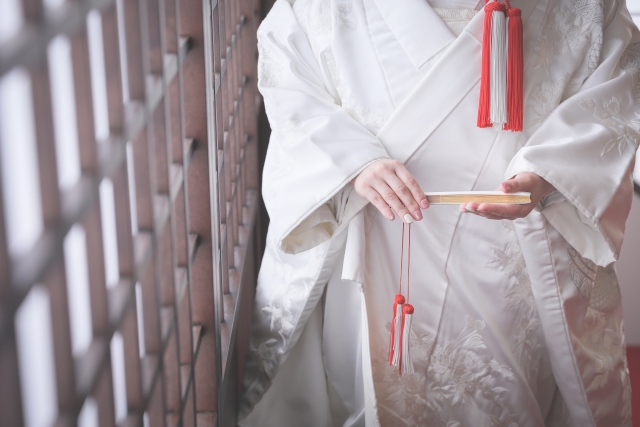
解説ポイント①:「白」の神聖性と花嫁の覚悟
白無垢の「白」が持つ意味は、単に「きれいだから」という理由ではありません。一つは、神道における神聖性の象徴です。白は清浄な色、神々の色とされ、神聖な儀式である結婚式に臨む花嫁に最もふさわしい色とされてきました。この考え方は、日本の文化の根底に流れる自然崇拝や八百万の神の思想と深く結びついています。
もう一つの重要な意味が、花嫁の決意の表明です。「嫁ぎ先の家風に染まる」というメッセージは、現代の価値観からすると少し古風に聞こえるかもしれません。しかしこれは、新しい家族の一員として、その家の文化や価値観を受け入れ、共に生きていくという強い覚悟の象徴なのです。自分の過去を一度「無」にし、新しい色に染まる準備ができているという、花嫁の潔さと謙虚さを表しています。
解説ポイント②:小物一つ一つに宿る物語
白無垢の小物は、単なるアクセサリーではありません。それぞれが花嫁の人生の門出を祝い、守るための深い意味を持つお守りです。
- **懐剣(かいけん)**は、武家社会の「自分の身は自分で守る」という精神性を今に伝えています。これは女性の強さと独立心をも象徴しており、単に従順であるだけでなく、いざという時には家族を守るという意志の現れとも解釈できます。
- **筥迫(はこせこ)**は、現代で言えば「女子力」の象徴かもしれません。「いつまでも夫にとって魅力的な妻でいられるように」という願いを込め、身だしなみ道具を入れていました。単なる飾りではなく、女性としての嗜みと誇りを表すアイテムだったのです。
- その他にも、金や銀の糸で織られた**抱え帯(かかえおび)や、帯に差す帯締め(おびじめ)**など、白一色の中に繊細な美しさを加えています。
これらを知ることで、白無垢姿の花嫁を見る目が少し変わるかもしれません。
解説ポイント③:綿帽子と角隠しの選択が示す意味
白無垢に合わせる髪飾りには、大きく分けて「綿帽子」と「角隠し」の二種類があり、その意味は大きく異なります。
- 綿帽子(わたぼうし): 真綿を広げて作られた、ふっくらとした袋状の被り物です。もともとは外出時のホコリ除けや防寒具でしたが、婚礼衣装としては**「挙式が終わるまで、新郎以外の人に顔を見せない」**という意味が込められています。その奥ゆかしさから、非常に初々しい印象を与えます。重要なのは、綿帽子は最も格式高い白無垢にしか合わせることができないという点です。
- 角隠し(つのかくし): 幅の広い布で、文金高島田に結った髪の上に被ります。その名の通り、**「怒りの象徴である角を隠し、従順でしとやかな妻になる」**という誓いを表しています。こちらは白無垢だけでなく、色打掛や引き振袖など、他の和装の婚礼衣装にも合わせることが可能です。
どちらを選ぶかは、花嫁がどのような想いを表現したいかによります。奥ゆかしさを大切にするなら綿帽子、凛とした気品を表したいなら角隠し、といった選択が考えられるでしょう。
参考文献
- 花嫁衣裳「白無垢」の由来と意味を知ろう。小物や髪型も解説! |マイナビウエディング
- 白無垢とは?意味や歴史、選び方のポイントを徹底解説|HANAYUME
- 白無垢とは?意味や歴史、選び方のポイントを徹底解説 – GINZA WEDDING
- 【白無垢のすべて】由来や意味・着こなし・髪型・費用相場を徹底解説!
【English Article】
The Profound Meaning of Shiromuku: A Guide to the Japanese Bridal Kimono
When you picture a traditional Japanese wedding, the image of a bride in a pure white gown, the shiromuku, often comes to mind. Its sacred and dignified presence captivates the hearts of all who see it. But why is it entirely white? And what wishes are woven into this attire? The shiromuku is more than just a beautiful garment; it is a story in itself, spun from Japan’s rich culture and the deep feelings of a bride-to-be.
- The Sanctity of “White” and a Bride’s Resolve: We will uncover the dual meaning behind the color white in a shiromuku, representing both sanctity and a bride’s commitment.
- Stories Nestled in Every Accessory: A shiromuku is not just about the kimono. We will delve into the secret roles and stories of the small accessories that adorn the bride, such as the kaiken dagger and the hakoseko purse.
- The Meaning Behind Choosing a Wataboshi or Tsunokakushi: We will explore the differences between the two distinct headpieces that complete the shiromuku look, the wataboshi and the tsunokakushi, and the unique symbolism each holds.
What is a Shiromuku? The Pure White Tradition Worn by Brides
The shiromuku is a traditional Japanese bridal kimono ensemble where every element, from the outer coat (uchikake) to the inner kimono (kakeshita), the sash (obi), the sandals (zori), and all the accessories, is a uniform white. Its history dates back to the Muromachi period, when it was used as the wedding attire for daughters of samurai families. It was considered the most formal and high-status wedding dress, a sacred outfit suitable for a ceremony before the gods.
This pure white attire symbolizes the bride’s purity and innocence, as well as her solemn determination for the new life ahead. It is truly the crystallization of Japan’s traditional beauty.
The Deep Meaning Embedded in All-White
Why is everything unified in “white”? This is deeply connected to how colors are perceived in Japanese culture.
Since ancient times, white has been considered the color of sunlight and treated as a sacred color. This is why the garments of Shinto priests and the decorations used in religious festivals are white. It was thought to be the most appropriate color for a bride vowing her marriage to the gods.
Furthermore, in addition to its meaning of “purity” and “innocence,” the color white carries the bride’s resolve to “be dyed in the colors of your family.” It expresses the strong will of past Japanese women to leave their birth home, enter the groom’s family in a pure white state, and follow the customs of that household. Wearing the shiromuku is also a ritual of “rebirth,” resetting the past and embarking on a new life.
The Aesthetics That Dwell in Unseen Details: The Shiromuku Accessories
The shiromuku ensemble is completed not only by the kimono itself but also by the accessories worn at the chest and on the sash. Each of these items is imbued with wishes for the bride’s happiness.
- Hakoseko (筥迫): This originated from a type of paper case carried by women of the samurai class during the Edo period. It’s like a modern makeup pouch, containing items for grooming like a mirror and a comb. While now largely decorative, it carries the wish, “May you remain beautiful forever.”
- Kaiken (懐剣): This was originally a short dagger carried by samurai women for self-defense. It symbolizes a noble spirit of “protecting oneself” and also serves as a talisman to ward off evil and misfortune.
- Suehiro (末広): This is a white folding fan. As its name, which means “spreading out at the end,” suggests, it is a lucky charm filled with the wish, “May your happiness spread and grow indefinitely.”
These small items are also symbols of the family’s wishes for the bride’s happiness and prosperity.
Traditional Japanese Weddings and the Shiromuku
The basic components of a shiromuku are the uchikake (outer robe), kakeshita (the furisode kimono worn underneath), an obi (sash), and the aforementioned accessories. The head is traditionally adorned with a wataboshi or a tsunokakushi.
In recent years, while preserving the traditional style, more brides are enjoying modern arrangements, such as incorporating Western-style hairstyles or carrying bouquets. The shiromuku, while slightly changing its form with the times, continues to be passed down as the most formal and radiant attire for a Japanese bride.
Analysis Point ①: The Sanctity of “White” and a Bride’s Resolve
The meaning of “white” in a shiromuku is not simply because it’s “pretty.” One aspect is its symbolism of sanctity in Shintoism. White is considered a pure, divine color, making it the most suitable for a bride participating in the sacred ceremony of marriage. This belief is deeply intertwined with the underlying Japanese cultural concepts of nature worship and the “eight million gods” (yaoyorozu no kami).
Another crucial meaning is the declaration of the bride’s resolve. The message of “being dyed in the colors of your new family” might sound a bit traditional from a modern perspective. However, it symbolizes a strong commitment to accept the culture and values of the new family as a new member and to build a life together. It represents the bride’s grace and humility, showing she is ready to render her past “blank” and be colored anew.
Analysis Point ②: Stories Nestled in Every Accessory
The accessories of a shiromuku are not mere ornaments. Each one is a charm with a deep meaning to celebrate and protect the bride on her new journey.
- The Kaiken (懐剣) dagger carries the spirit of the samurai society, “to protect one’s own self,” into the present day. It also symbolizes a woman’s strength and independence, suggesting not just obedience but also the will to protect her family in times of need.
- The Hakoseko (筥迫) could be seen as a symbol of “feminine grace” in modern terms. It held grooming tools, embodying the wish, “May I always remain an attractive wife to my husband.” It was not just a decoration but an item that represented a woman’s refinement and pride.
- Other items, like the kakae-obi (a sash woven with gold and silver threads) and the obijime (a decorative cord tied around the main obi), add a subtle beauty within the all-white ensemble.
Knowing this might just change the way you see a bride in her shiromuku.
Analysis Point ③: The Meaning Behind Choosing a Wataboshi or Tsunokakushi
There are two main types of head coverings worn with a shiromuku, the wataboshi and the tsunokakushi, and their meanings are quite different.
- Wataboshi (綿帽子): This is a soft, hood-like headpiece made from fluffed silk floss. It was originally used to protect from dust and cold when outdoors, but as bridal wear, it carries the meaning “not to show her face to anyone but the groom until the ceremony is over.” It gives a very innocent and modest impression. Crucially, the wataboshi can only be paired with the most formal shiromuku.
- Tsunokakushi (角隠し): This is a wide band of cloth worn over the bunkin takashimada hairstyle. As its name, “hiding horns,” suggests, it represents a vow to “hide the horns of anger and jealousy and become an obedient, gentle wife.” This headpiece can be worn not only with a shiromuku but also with other formal Japanese wedding kimono like the iro-uchikake (colored outer robe).
The choice between them depends on what feelings the bride wishes to express. One might choose the wataboshi for its modesty and grace, or the tsunokakushi for a dignified and noble appearance.



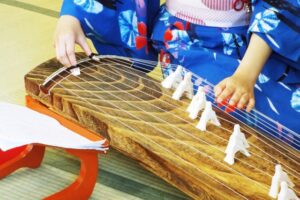
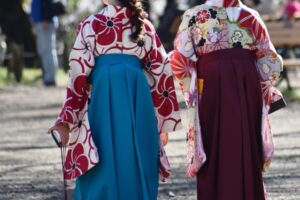
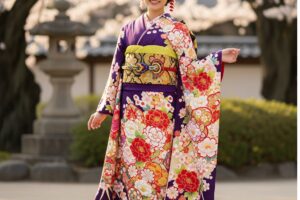
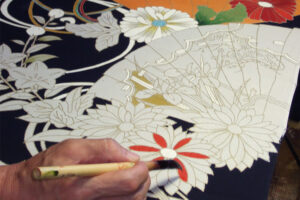
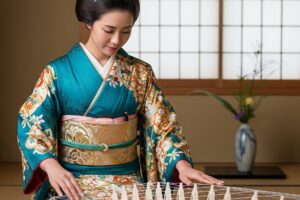
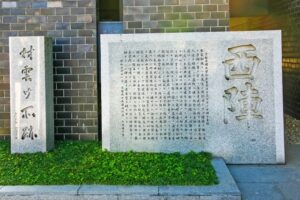
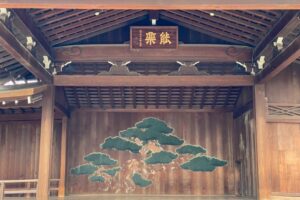
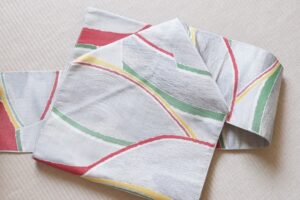
コメントを残す